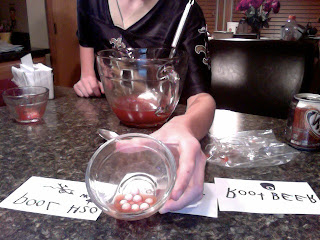We have been working on science experiments for the past few weeks. They are fun and challenging. For example, we did a Gobstopper experiment. Mrs. Sibberson got this idea from reading Mr. Keefer's blog. When we do Science Challenges, we learn about creating good experiments to our questions. We try to make better predictions or hypothesis. We take observations and write those down. We keep track of what we notice on paper. Some people make tables. Some people take videos. Some people take pictures. We also talk about variables-what you have to keep the same in an experiment.
So, last week, we each came up with our own question about Gobstoppers and we experimented at home.
Student 1: My question was, "What would happen if I put Gobstoppers in hot water and salt?" My prediction was that it would disintegrate faster than in regular water. First I got a cup and put hot water in it. Then I added salt. Then I added the Gobstoppers. I kept a paper where I wrote words about what I noticed.
Student 2: My question was, "What would happen if I used more candies in a warmer temperature?" but when I got home it was really cold out. So I decided to just use more candies. So my new question as, "What would happen if I used different kinds of candies in warm water?". First I got out a glass of water. I filled it with cold water. Then I put the Gobstoppers in. Then I put in a mint. After that, I added a little bit of hot water. When that happened, the colors that came off the candy went everywhere. After that, I added some PEZ. It didn't do much. The big difference in my experiment from the first experiment, was that the color went everywhere in the water. In the first experiment, it just stayed on the bottom. I used paper, a pencil and some colored pencils to draw my observations. I wrote notes about what happened.
 |
| Student 2's Observations |
Student 3: My questions was, "What would ice do to the Gobstoppers?" When I got home, I got out my Gobstoppers and I got some cold water. Then I froze it with the Gobstoppers in it. I checked on it every 5 minutes. At 20 minutes, I took it out and saw that there were cracks in the Gobstoppers. I took notes on what I saw in the freezer every five minutes.
Other kids in our class had awesome observations and photos.
 |
| One student used various liquids including water from the local swimming pool (with permission, of course!). |
 |
| This is what Gobstoppers look like after they have been in Sierra Mist. |
Loved your questions and what fun experiments. I am a teacher coach and will share this with other teachers. Thanks for being great examples for other teachers and their students. You have an amazing teacher. I'm kind of a super fan of hers!!
ReplyDeleteI loved this idea and all of your questions and hard work. I'm a teaching coach and I will share your hard work and ideas with some of my new teachers. Thanks for setting such a good example for other learners. You have an AMAZING teacher who's work I have used to train many teachers in my district. I'm kind of a super fan. Keep asking those great questions.
ReplyDeleteIt's a super exercise to do & I liked all the different approaches to the gobstoppers, including other candy, too. Good comparison! Freezing is another good effect for some things, & the Sierra Mist possibly had the most effect. Did you all share what made the most different change? Thanks for all of the information in your experiments. I will share with others, too, like Robin above.
ReplyDelete